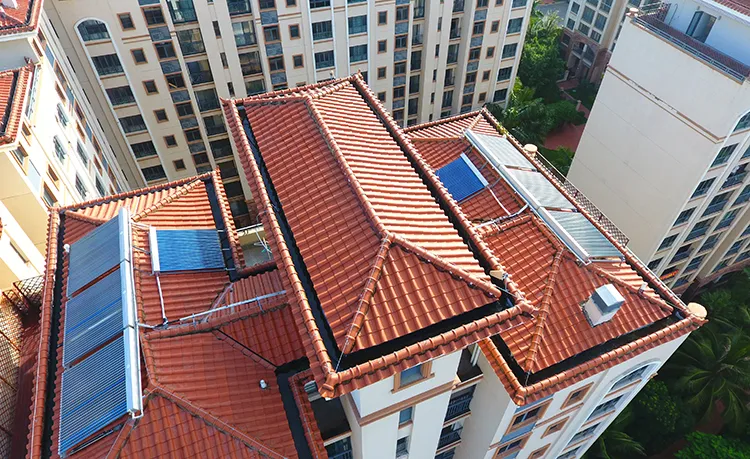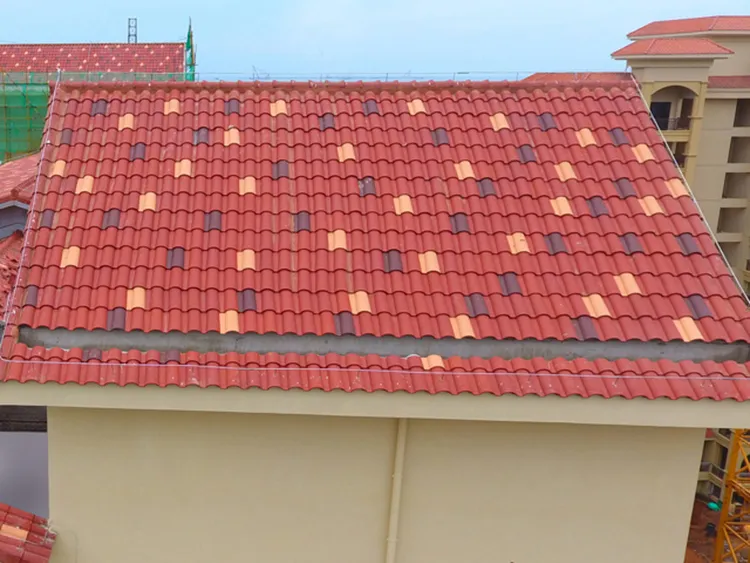Clay roof tiles have been one of the most important materials in construction since ancient times, and are known for their durability, beauty, and waterproofness. Although clay tiles are used all over the world, the design and production process of tiles in different regions are different.
Spanish clay roof tiles and Roman clay roof tiles are the two most representative types of tiles, and they have obvious differences in appearance, production process, installation method, and application scenarios. This article will explore the characteristics and differences of these two tiles in detail to help readers better understand and choose the right roof tiles.

What Are the Characteristics of Spanish Clay Roof Tiles?
Characteristics of Spanish clay roof tiles: appearance and design (adopting S-shaped design, commonly known as "Spanish tiles" or "Spanish S tiles"), production process (made of natural clay fired at high temperature), installation method (staggered stacking, fixed by nails or hooks), widely used in Mediterranean-style buildings.
1. Appearance and design: Spanish clay tiles usually adopt S-shaped design, commonly known as "Spanish tiles" or "Spanish S tiles". This tile is wavy and can well simulate the appearance of traditional handmade tiles. The S-shaped design is not only beautiful, but also effectively guides rainwater flow and prevents roof leaks.
2. Production process: Spanish clay tiles are made of high-quality natural clay and fired at high temperatures. In modern processes, some minerals are usually added to enhance the hardness and weather resistance of tiles. During the firing process, clay tiles will undergo multiple inspections to ensure their quality and consistency.
3. Installation method: Spanish clay tiles are usually installed on the roof in a staggered and stacked manner. This installation method can provide better waterproofing and wind resistance. Each tile is fixed to the wooden beams or metal brackets of the roof by nails or hooks, and the overlapping parts between tiles can form a waterproof barrier.
4. Application scenarios: Spanish clay tiles are widely used in Mediterranean-style buildings such as Spain, Italy and Greece. Its unique appearance and color can add a strong Mediterranean style to the building and is suitable for roof decoration of villas, resorts and historical buildings.

What Are the Characteristics of Roman Clay Roof Tiles?
Features of Roman clay roof tiles: appearance and design (unique curved design, also known as "Roman tiles" or "barrel tiles"), manufacturing process (similar to Spanish tiles, both are fired at high temperature), installation method (alternately stacking the bottom tiles and cover tiles), Roman clay tiles are widely used in traditional buildings in Europe and the Mediterranean region.
1. Appearance and design: Roman clay tiles, also known as "Roman tiles" or "barrel tiles", have a unique curved design. This type of tile usually consists of two parts: one is a concave bottom tile and the other is a convex cover tile. The bottom tile and the cover tile cooperate with each other to form a perfect curved curve with a strong visual impact.
2. Manufacturing process: The manufacturing process of Roman clay tiles is similar to that of Spanish tiles, both of which are fired at high temperature. However, the curved design of Roman tiles requires higher manufacturing precision and consistency. Therefore, more stringent quality control is required during the production process to ensure that the size and shape of each tile fit perfectly.
3. Installation method: The installation method of Roman clay tiles is relatively complicated, and the bottom tile and cover tile need to be alternately stacked on the roof. The bottom tile is laid on the wooden beams or metal brackets of the roof, while the cover tile is covered on the seams of the bottom tile to form a continuous waterproof barrier. This installation method can provide excellent waterproof performance and wind resistance, but it also requires higher installation technology and time.
4. Application scenarios: Roman clay tiles are widely used in traditional buildings in Europe and the Mediterranean, especially in classical architecture in Italy and Greece. Its unique curved design and classical beauty can add a strong historical and cultural atmosphere to the building, and is suitable for roof decoration of churches, museums and historical sites.

What Are the Main Differences Between Spanish Clay Tiles Vs. Roman Clay Tiles?
Appearance and design:
Spanish clay tiles are famous for their wavy S-shaped design, while Roman clay tiles are famous for their unique curved design and the combination of bottom tiles and cover tiles. The two tiles have obvious differences in appearance. The former is more modern and Mediterranean, while the latter has a strong classical beauty and historical atmosphere.
Manufacturing process:
Although both tiles are made by high-temperature firing, the curved design of Roman clay tiles requires higher manufacturing precision and consistency. During the manufacturing process, Roman tiles require stricter quality control to ensure that the size and shape of each tile fit perfectly.
Installation method:
The installation method of Spanish clay tiles is relatively simple, and they are installed on the roof in a staggered stacking manner, while the installation method of Roman clay tiles is relatively complex, requiring the base tiles and cover tiles to be stacked alternately. This installation method makes Roman tiles more waterproof and wind-resistant, but it also requires higher installation technology and time.
Application scenarios:
Spanish clay tiles are widely used in Mediterranean-style buildings, such as villas, resorts, and historical buildings; while Roman clay tiles are widely used in traditional buildings in Europe and the Mediterranean, especially in churches, museums, and historical sites. The two also have obvious differences in application scenarios. The former is more suitable for modern and Mediterranean-style buildings, while the latter is more suitable for classical and historical buildings.

How to Choose the Right Clay Tile for Me?
Choose according to the architectural style:
When choosing clay tiles, the overall style of the building should be considered first. If the architectural style tends to be Mediterranean, Spanish clay tiles can be selected; if the architectural style tends to be classical and historical, Roman clay tiles can be selected.
Choose according to climatic conditions:
Climatic conditions are also an important factor in choosing clay tiles. The wave-like design of Spanish clay tiles can effectively guide the flow of rainwater, which is suitable for areas with heavy rainfall; while the curved design and double-layer stacking of Roman clay tiles can provide better waterproof performance and wind resistance, which is suitable for areas with strong winds.
Choose according to the budget:
Budget is also an important factor to consider when choosing clay tiles. The production and installation of Spanish clay tiles are relatively simple and low-cost; while the production and installation of Roman clay tiles are more complicated and costly. Therefore, you can choose the right tiles according to your budget.
Conclusion
There are obvious differences between Spanish clay tiles and Roman clay tiles in appearance, production process, installation method and application scenarios. By understanding these differences, consumers can better choose clay tiles that suit their architectural style and needs. Whichever clay tile you choose, you need to ensure its quality and installation workmanship to ensure the durability and beauty of your roof.

